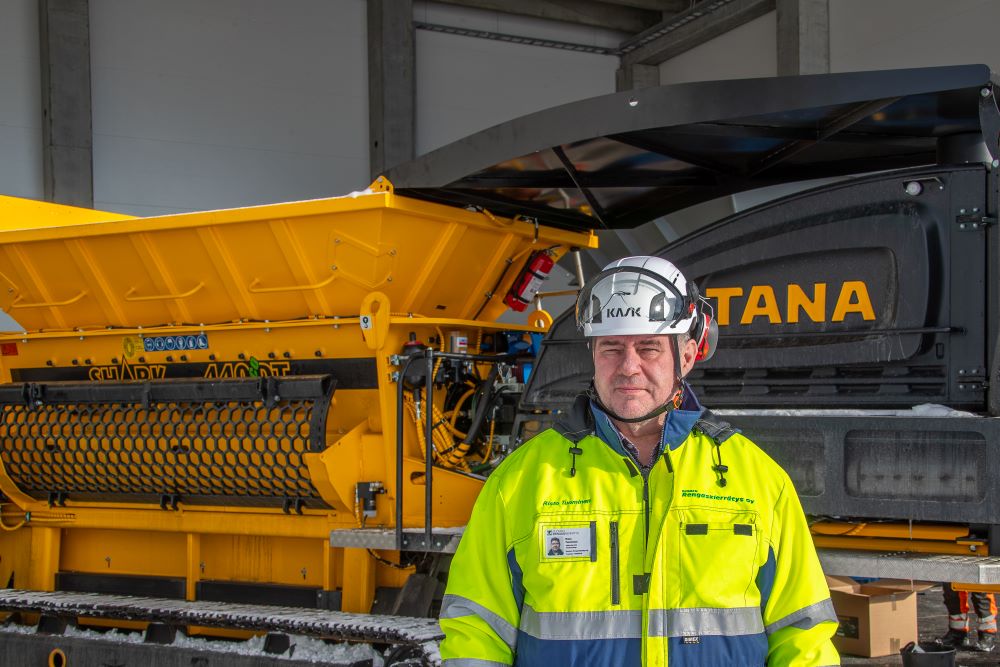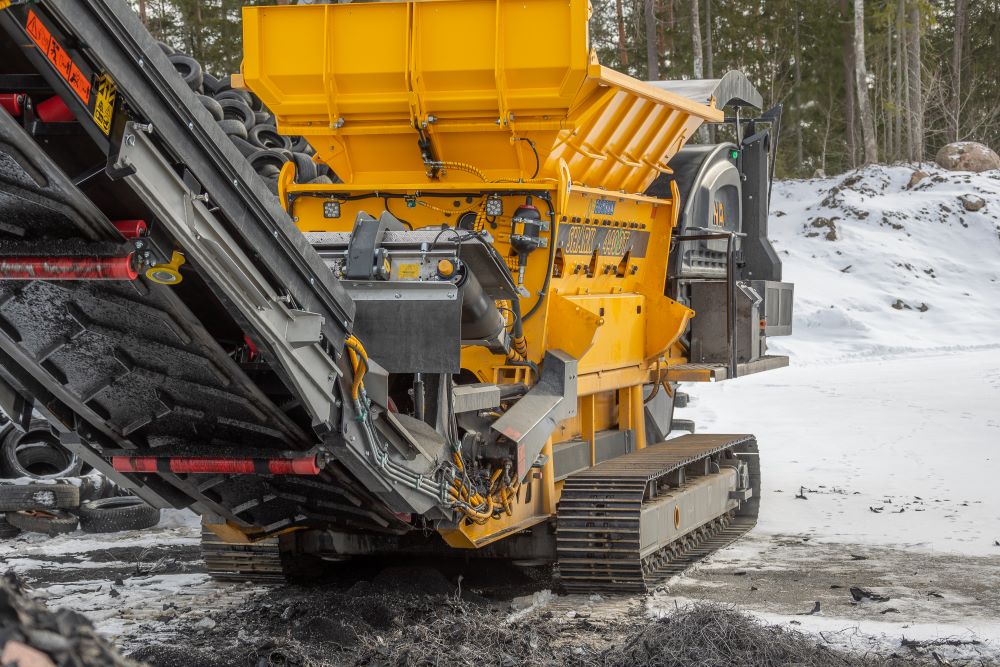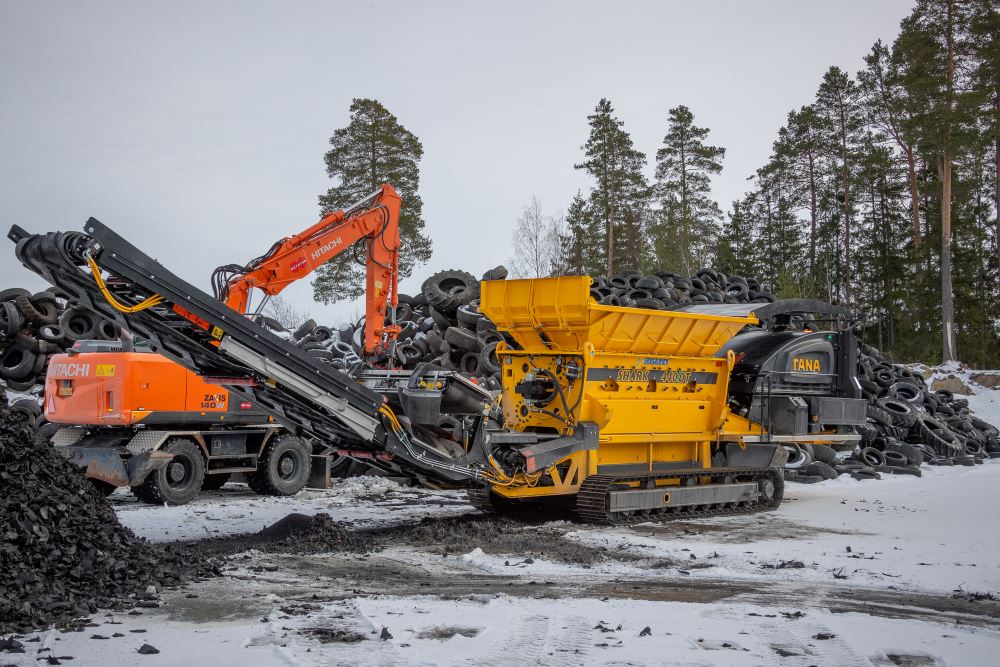Article originally published in Koneurakointi 3/2023. Text & images: Juha Pokki
The main function of a tyre is to rotate, but when the active rotation eventually stops, the journey of the rubber ring still does not stop – at least in Finland.
Tyre recycling in our country is a decades-old tradition that is gathering speed all the time, in which valuable materials are recovered for use from used tyres.
Back in the mid-1990s, Finland could only dream of the current, widespread and versatile recycling of useful materials in which goods that were no longer needed would end up somewhere other than in open landfills. It was during this period that the recycling operations that have since become so significant in our country were introduced. Founded in 1995, Finnish Tyre Recycling Ltd, as its name suggest, was and still is responsible for the waste management of end-of-life tyres.
Over the decades, however, the task of the producer organisation has changed concretely. Whereas in the early days the organisation mainly oversaw tyre recycling activities, today it is active in the circular economy on a practical level. Since the beginning of the current year, the organisation has been responsible for collecting and processing tyres itself, as well as marketing the recycled materials to downstream users.
This change has meant not only growing the organisation, but also making significant investments in practical operations. Its brand-new circular economy facility in Loppi will enter full production during the spring, its collection terminals throughout Finland will be operated together with Encore Environmental Services, and the entire logistics organisation has been rebuilt together with six transport partners. In addition, it will process tyres at the new facility in Loppi, as well as at its terminals and other locations, using its own machinery and equipment instead of subcontracting to operators. To tackle this demanding job, Finnish Tyre Recycling decided to purchase a new TANA Shark 440DTeco mobile waste shredder.

Mobile shredder makes sense
Although the machine and the self-sufficient operating model are essentially new to Finnish Tyre Recycling, this is not the company’s first experience with shredding tyres. Managing Director Risto Tuominen is a long-time tyre recycler who has probably seen and experienced everything this industry can offer. As a result, he has a strong opinion about the equipment required for recycling.
“With our new operating model, we needed our own mobile shredder, even though we have a pre-shredder here at our new facility in Loppi that can be used to process most of the tyres that arrive here before they proceed to actual production,” Tuominen explains. “The mobile shredder will be used at our reception terminals and other construction sites whenever there is a need to produce tyre shred onsite. In addition, the TANA can be used as a back-up machine for the pre-shredder if the situation requires it,” he adds.
Previously, this job was performed by a subcontractor, but the decision to take shredding into its own hands was made for a few key reasons. “First of all, it was a case of simple maths: by doing it ourselves and using our own equipment, we calculated that this would be more cost-effective. In addition, when the entire process is in our own hands, we can easily change not only the piece size, for example, but also make sure of the quality of the tyre shred,” Tuominen states.

Tyres circulate in Finland
The quantities in question are considerable. Finnish Tyre Recycling collects and processes 100% of Finland’s recyclable tyres, and the recycling percentage is correspondingly high: practically all end-of-life tyres are reused sooner or later. Finnish Tyre Recycling’s network of more than 3300 collection terminals covering the whole of Finland makes sure of this.
Everything has been made easy for consumers, who only have to pay a small recycling fee that is included in the purchase price of new tyres. No other steps are necessary, because tyre work is usually performed at tyre shops, so end-of-life tyres stay there and end up being recycled. The extensive network of collection terminals in turn guarantees that they are easy to find for those who prefer to change tyres in their own garage. Even in this case, a separate reception fee is not charged, as it is already included in the price of the tyre. All tyre shops and other businesses that change tyres that have signed an agreement with Finnish Tyre Recycling accept rimless tyres free of charge.
All the rest is taken care of by Finnish Tyre Recycling. And that’s a lot, because the previously mentioned almost perfect recycling rate means that, measured in weight, about 65,000 tonnes of tyres are recycled each year. In fact, this is an even higher amount than official tyre imports combined with local manufacturing in Finland on an annual basis.
Valuable materials should not be overlooked
It goes without saying that something has to be done about this huge amount – collecting old tyres is not enough in itself, nor is it worth it. A significant quantity of valuable materials is contained in tyres, even after the tread has worn out. The most useful component, of course, is the rubber compound.
TANA’s role in the recycling process is to shred the tyres. The advantage of shredding tyres already at the collection terminals is that it makes transportation more efficient. Shredded tyres weigh approximately half a tonne per cubic metre, so transporting a large amount of tyres in shredded form is more efficient than transporting whole tyres. At the same, round-trip traffic is also reduced compared to centralised operations. If the tyre shred can be used locally, it should also be produced locally using a mobile shredder.
One of the locations where mobile shredding is being carried out is the collection terminal in Lieto, where Peter Blomberg from Encore Environmental Services is feeding tyres into the TANA shredder. The stack contains a wide variety of tyres, representing just about everything that is covered by producer responsibility in terms of recycling: all types of vehicle tyres, including trailer tyres, can probably be found here if you were to dig through the pile.
Fortunately, Blomberg does not have to be too picky, as the TANA shredder has an appetite for almost everything. The grapple picks up tyres that were once used on scooters, wheel loaders and, of course, passenger cars. The slow-spinning rotor shreds tyre after tyre without hesitation, and the automated smart control system ensures that the rotor is reversed if necessary.

A steady pace is the most effective method
At the collection terminal in Lieto, tyres disappear from the stacks at a steady pace and are processed not only into tyre shred, but also steel balls. A magnet effectively separates the reinforcing steel material that comes off when shredding the tyres, and any remaining metals are separated during processing at the recycling facility in Loppi. The resulting steel fractions are then sent for further processing and eventually supplied to the steel industry as recycled raw materials.
With his long experience, Peter Blomberg always knows how to feed the right amount of tyres into the Shark at a time in order to maintain a steady production. “Around six to eight tonnes of tyres are shredded per hour, but watching the stacks disappear is in easier way of measuring progress,” Blomberg admits. “There is no point trying to break records, because that just increases the risk of something going wrong,” he continues.
Feeding the shredder therefore also requires an understanding of how tyres behave, the capacity of the machine and the conditions. “I don’t really need to place the tyres in the shredder or keep a close eye on what is happening, as I can feel how it’s going. You can also tell when the knives need to be switched or adjusted just by the way the tyres go through the machine, rather than by the quality of the tyre shred,” Blomberg explains.
“Of course, new knives are always the best, and they need to be adjusted somewhere between 100 and 120 hours. They then need to be changed after a similar period. Tyres cause a surprising amount of wear on the knives, even though you might not believe it. Fortunately, the knives on the TANA are among the most durable,” Blomberg confirms.
According to Blomberg, different types of tyres do not cause any significant changes to his work or the operations of the shredder, but the most challenging ones are so-called puncture-proof tyres. “The sealant used in the tyres can cause problems, as it sticks to the knives very effectively.”
Tyres can be a challenge for shredders
According to Risto Tuominen, Finnish Tyre Recycling chose TANA after a long process of comparing machines. Previous experiences were naturally one factor, but at the same time the machine’s versatility and domestic content were also decisive. A few other brands were also in the final running. “I have always said that tyres are too good, at least when it comes to shredding them. A lot of strength is needed to counter the resistance caused by friction, stretching and the metal content,” admits Tuominen. “Changing the particle size is also easy with the TANA, and that too was an important consideration for us,” he adds.
Finnish Tyre Recycling’s new TANA Shark 440DTeco was also specified with many special features. The rotor is an HD+ model with a 50mm frame instead of the normal 35mm for even more durability. Heat can also be a challenge, especially in hot weather, and it can even cause a fire hazard in the worst-case scenario. Therefore, the new Shark was equipped with a fire extinguishing system and a cooling system.
Increasingly flexible opportunities
Once a tyre has been shredded, it can continue its journey towards a new life in various forms. Traditionally, the biggest demand for tyre shred has been in civil engineering. “Tyre shred is a very good material for lightening the mass and for protecting against water and heat,” says Risto Tuominen. “But in the future, with our new recycling facility in Loppi, we will be able to produce more and more recycled raw material also for the rubber and plastic industry.”
On an annual basis, this means converting 20,000 tonnes of tyres into rubber granulate and powder. The utility rate is high, because around 16,500 tonnes of these materials can be produced from 20,000 tonnes of tyres once the steel and fabric fibres have been removed. Granulate can be used, for example, for various structures that require flexibility. Rubber powder, in turn, is used by the rubber and plastic industry for demanding products that require elastic properties. Rubber powder can replace approximately 25 to 75 percent of the raw material of the finished product.
Another traditional application for recycled tyres is blasting mats. This will continue to be the case also in the future, because even while the utilisation of tyres is becoming more diverse, there seems to be no end in sight to the work. Even as methods develop, mechanical shredding will always be needed, Risto Tuominen points out.
“Even if chemical recycling becomes more common, it will still require shredding the tyre first. There will certainly be enough work for our TANA!”